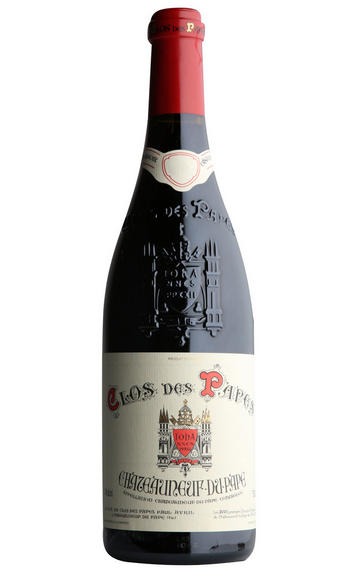
2010 Châteauneuf-du-Pape Rouge, Clos des Papes, Paul Avril & Fils, Rhône
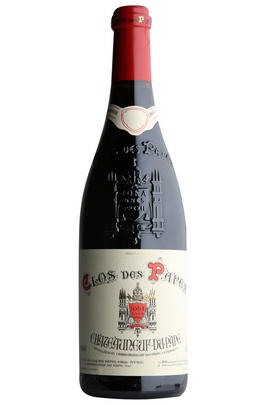
Critics reviews
Jeb Dunnuck - 14/09/2015
(Jancis Robinson & Julia Harding MW - www.jancisrobinson.com - 20 Dec 2011)
It is an extraordinarily intense, fresh, lively wine with great finesse and elegance, which is somewhat unusual given the richness of fruit and the power of this wine. The color is a dense ruby/purple, perhaps slightly less opaque than the 2007, but very dark. This wine should evolve for 30+ years.
(Robert Parker - Wine Advocate #197 Oct 2011)
This is one of the great estates in Chateauneuf du Pape, with a history that dates back to the mid-1700s. Clos des Papes, with its 90+ acres of vines spread among 24 separate parcels in the appellation, is one of the traditional hallmarks of classic, long-lived Chateauneuf du Pape. Everything is aged in old wood foudres, no old vine or luxury cuvee is produced, and the red wine is a classic blend of 65% Grenache, 20% Mourvedre, 20% Syrah, and the rest Vaccarese, Counoise, and Muscardin. It is generally not fined or filtered after aging 15 months in these old wood foudres.
About this WINE
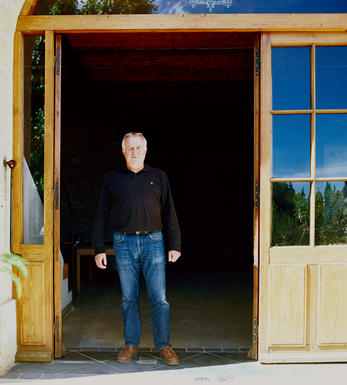
Paul Avril et Fils
With Vincent Avril at the helm, Clos des Papes is one of the most highly regarded properties; not only in Châteauneuf-du-Pape, but in the world of wine. This family estate has been certified organic for 15 years, with high attention to detail translating into impressively low production levels. Given that the vines here average over 50 years of age, they are firmly prepared and able to withstand many ordeals, including Mistral winds at 140 kilometres an hour, severe heatwaves and drought conditions. Thankfully, they were spared from the latter two in 2020.
When you visit this iconic estate, what stands out most is the complete focus on the vineyard and the absolutely hands-off approach in the cellar. The wines are amongst the purest expression of terroir you could ever wish to taste. There is a magic here that transcends the liquid in the bottle – Clos des Papes is a nonpareil of sheer brilliance.
Vincent is exceptionally happy with his ’20 wines, saying, “I can tell you ’20 is, I think, a great year that will stand the test of time. A very balanced, fine vintage with great freshness, silky tannins and good length in the mouth. Everything was climatically united, both for the red and the white. Currently, ’20 reminds me of ’05 and ’07.”
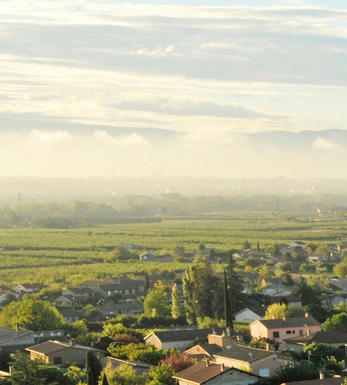
Châteauneuf-du-Pape
The most celebrated village of the Southern Rhône, Châteauneuf-du-Pape is the birthplace of the now indispensable French Appellation d’Origine Contrôlée system – imperfect though it may be. Compared to the Northern Rhône, the vineyards here are relatively flat and often feature the iconic galet pebbles – the precise benefits of which are a source of much debate. Minimum alcohol levels required by the AOC are the highest in France, but at 12.5% it is well below the natural generosity of Grenache, which only achieves its full aromatic potential when it is fully ripe and laden with the resultant high sugars. Syrah and Mourvèdre contribute the other defining elements in the blend, adding pepper, savoury spice and structure to the decadent Grenache. There are a further 10 permitted red grape varieties which can be used to adjust the “seasoning”. Of the five white varieties permitted, it is Grenache Noir’s sibling – predictably perhaps – Grenache Blanc, which dominates, though Roussanne shows a great deal of promise when handled well, notably at Château de Beaucastel.
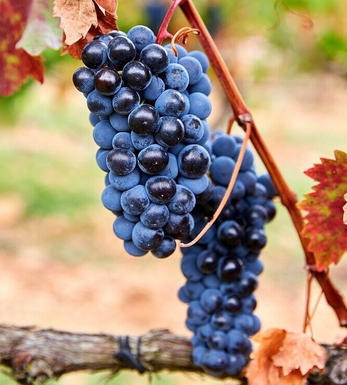
Southern Rhône Blend
The vast majority of wines from the Southern Rhône are blends. There are 5 main black varieties, although others are used and the most famous wine of the region, Châteauneuf du Pape, can be made from as many as 13 different varieties. Grenache is the most important grape in the southern Rhône - it contributes alcohol, warmth and gentle juicy fruit and is an ideal base wine in the blend. Plantings of Syrah in the southern Rhône have risen dramatically in the last decade and it is an increasingly important component in blends. It rarely attains the heights that it does in the North but adds colour, backbone, tannins and soft ripe fruit to the blend.
The much-maligned Carignan has been on the retreat recently but is still included in many blends - the best old vines can add colour, body and spicy fruits. Cinsault is also backtracking but, if yields are restricted, can produce moderately well-coloured wines adding pleasant-light fruit to red and rosé blends. Finally, Mourvèdre, a grape from Bandol on the Mediterranean coast, has recently become an increasingly significant component of Southern Rhône blends - it often struggles to ripen fully but can add acidity, ripe spicy berry fruits and hints of tobacco to blends.


Buying options
Add to wishlist
Description
Aged in large photogenic old foudres, this is to be a blend of of 65% Grenache, 20% Mourvedre, 20% Syrah, with the balance made up of Vaccarese, Counoise, and Muscardin. High in both alcohol and acidity, not to mention dry extract, this wine promises to be one of the great Clos des Papes, up there in the hall of fame with the 1990 and the 1978. The purity and exuberance of the Grenache fruit are a joy to behold, with the extra savoury allure of the Mourvèdre adding minor key harmony de profondis.
Simon Field MW, BBR Buyer, February 2012
Vincent Avril, in a typically fascinating tasting, had prepared four pre-assemblages, of which one was set to be closest to the final blend. The differences between the four, with their varying degree of differing grapes, from differing sites, was extremely instructive. All were excellent but the final foudre seemed to be richer, longer and more complete. A very valuable lesson in the blender’s art, and for Vincent, all the components are vital, hence his insistence, probably in defiance of huge commercial reward, to resist the temptation of creating a super or deluxe cuvée. Such integrity is to be celebrated, most appropriately with a glass of Clos des Papes in one’s hand!
wine at a glance
Delivery and quality guarantee